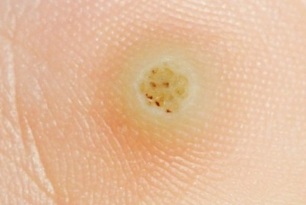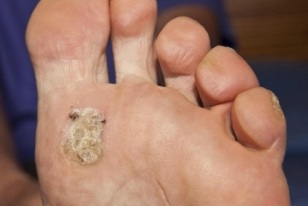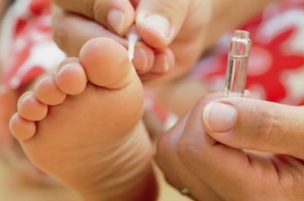
If a hard and coarse papule with a rough top appears on the base, it is either a plantar wart or a callus. The differences are significant, especially in the origin and methods of treatment. The wart grows as a sharp spike in the inner layer of the skin of the foot, causing severe pain. Doctors recommend removing this skin swelling if the shoe is damaged and inflamed.
Appearance of outgrowth on the base
The main part of the common wart on the leg grows inwards into the dermis. This is because from the outside, the tumor is pinched by hard surfaces: shoes, various coatings that we walk on. New growth cells appear from the soft tissue of the skin. Outside the photo of the plantar wart, a dense plaque or cylinder can be seen. The surface of the formation is free of skin lines, consisting of scales of horny material. Adjacent skin changes: it becomes denser, covered with a layer of keratin.
What does a plantar wart look like:
- a lump or plaque that rises 1 to 5 mm above the epidermis;
- is round, oval or polygonal in shape; The
- interface is hard and rough to the touch;
- color is pink, yellow-white or gray;
- formation diameter 1-20 mm;
- is missing the papillary pattern;
- edges are well delimited.
Leg warts are characterized by acute pain that interferes with gait to temporary disability.

Accumulation occurs in areas subject to intense pressure and sweating. Typical localization of the wart on the sole: heel, foot, and toes. Painful and difficult-to-remove formations appear on the edge of the nail and under the nail plate. All types of warts have blood vessels that feed on living tissues, intensively proliferating cells. Small black dots are visible on the surface - blood clots in the capillaries; they may bleed when the corneum layer is cut.
Plantar warts are most common in school-age children. In about 30% of patients, such formations resolve on their own in the first year. However, it is recommended to start treatment when the first symptoms appear, especially if the plantar wart hurts or there is a high risk of infection in the surrounding people. Infection is also dangerous when a group of formations appears in an area, with each papule merging into a mosaic board.
Wart - a manifestation of the papilloma virus
The skin on your feet is often damaged, compressed, and sweaty when you wear tight and uncomfortable shoes. If thin-walled blisters with clear fluid appear, they are corns. Sometimes a keratin layer is formed on the surface, but even so, typical skin lines remain.
The appearance of a wart on the base first goes unnoticed or is considered to be callus formation. The surface of the formation should be carefully inspected and the characteristic signs observed. It is severe keratinization, lack of skin lines, pain when the surrounding skin is compressed. These are the results of active reproduction of papilloma virus in living cells of the epithelium.
Causes of plantar warts:
- papilloma virus (HPV) infection;
- weakening of local and general immune defenses; activation of the virus
- , penetration into epithelial cells;
- increased the proliferation and rapid keratinization of infected cells.
HPV is spread through domestic and sexual contact. Infectious agents penetrate even through minor damage to the skin and mucous membranes: cracks, cuts, crying.
Papilloma viruses types 1, 2, 4, 27, and 57 predominantly infect cells in the skin of the foot. The plantar type of viral growths belongs to simple formations (common, vulgar). According to the international classification of diseases, these are infectious and parasitic diseases. Class ICD-10: "Viral infections characterized by lesions of the skin and mucous membranes. "
Simple warts are benign epithelial tumors. Initially, they do not pose a health hazard. Sometimes such growths go through a malignant transformation into a cancerous tumor. The process is more often triggered by HPV types with a high risk of developing cancer.
Foot Wart Treatment
After infection, the incubation period begins: the papilloma virus invades the cells, “shaping” their proliferation and development. Much more often, the infection becomes latent and in such an inactive state can persist throughout the life of the body. Immunity in this case suppresses the papilloma virus, puts it into sleep mode without special therapy.
Plantar warts can appear 3 to 10 years later, or a few weeks after infection, and then disappear within the first year or two.
Not everyone is ready to wait, expect spontaneous healing, and cleanse their skin of growth. Many see a doctor at the first signs of HPV infection. Dermatologists recommend modern methods of removing warts, recommend means of antiviral therapy, strengthen the immune system of the skin and the whole body.
If the type of HPV needs to be determined to make the right choice of therapy, your doctor will prescribe several additional tests. A biopsy is performed to collect histological material, and an analysis is performed to determine antibodies to the papilloma virus.

Handling options:
- Use of special medications for plantar warts. Dead cells dissolve and peel.
- Laser excision of simple tumors with the formation of a scarring during which healing takes place. The bark disappears 7-10 days after the procedure.
- Cryodestruction with liquid nitrogen. Large warts are removed in a number of procedures. When exposed to low temperatures, bubbles appear as after burning.
- Electrocoagulation through an electrode through which a high-frequency current is conducted to destroy abnormal tissues. A painful procedure accompanied by a strong smell of burning skin.
- Surgical removal.
- Drug injection.
It is recommended to use a special plaster at home at the beginning of the treatment. This affordable treatment is applied after softening the wart on the foot with warm water, cleansing the keratinized layers with nail scissors and pumice. A patch is then applied. The treatment lasts on average 1-3 months.
Prevention
Papilloma viruses can persist in the environment for long periods of time. It is necessary to keep your feet clean, do not go without shoes, especially in public changing rooms, bathrooms, in the pool. Special slippers should be used to protect the sole from contact with surfaces contaminated with other people’s particles. Do not wear socks and shoes for others.
Do not scratch the wart, otherwise similar growths will appear on other parts of the foot.
Papilloma viruses are highly contagious. Disinfect accessories for everyday hygiene and pharmaceutical applications. Socks and doormats should be washed thoroughly with hot water, scissors, nail file, pumice stone. Be sure to wash your hands with soap and water after touching the education, various medical procedures.














































































